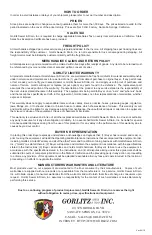
PROCEDURES AND TECHNIQUES FOR CLEANING A BLOCKED PIPE
At the Institute for Drain & Sewer Cleaning, the better part of the day is spent with “hands on” training
using both electro-mechanical equipment and high velocity water jets in sewers and plumbing fixtures. The
instructor may tell the class about the procedures and techniques for cleaning a pipe but until the technicians
perform the procedures, they have not really learned.
Drain and sewer cleaning is like any other trade (or profession if you prefer). There are certain rules
and procedures to be followed. The real skill involves the ability of the technician to execute the procedures.
Skills and talents vary with the individual. That’s the reason one sewer cleaner can follow another and clean a
pipe once thought impossible to clean. A wise homeowner told by a sewer cleaner that the pipe must be dig up
and replaced will ask for a second opinion and may discover the pipe, in fact can be cleaned without digging.
With these thoughts in mind, lets walk through the process of cleaning a drain or sewer. The technician will, first
of all analyze the design of the drain / waste / vent (dwv) sewer system and isolate the location of the blockage
and the possible cause of the blockage. Once the blockage has been located, the technician will make a series
of decisions to clean the pipe.
First, he will determine the size of the pipe. The size of the pipe determines the appropriate machine
and cable size and type, which will be used. (if the obstruction is soft, a high velocity water jet may be chosen.)
The length of the cable is important because the blockage may be beyond the reach of a shorter cable. If this
is the case, the technician may be able to add cable or find a closer access point to the blockage. A cleanout
may need to be installed. The choice of the cable size and type is important because a cable too small or too
weak for the pipe or the obstruction is more likely to be kinked or broken. A good cable must be flexible enough
to execute bends but strong enough to develop enough torque to clean the pipe. Proper cable selection is an
important factor in cleaning a pipe.
Once the proper machine, cable size, length and type have been chosen, the next choice is the
attachment for the cable if the blockage is in a drain, the choice is normally limited to a blade, a bulb, a hook, or
a drophead attachment. If the technician is confident, he can pass a full-size blade the first time he will select
that size blade to cut loose the obstruction. Discretion usually dictates the use of a smaller blade through a pipe
before a larger blade is used.
The bulb attachment is designed to clear the obstruction by passing through it or pushing it out
the pipe. The hook attachment is a “mini-retriever “ designed to bring back the blockage if it can be physically
removed. The drophead is a swing attachment designed to execute a tee. It also has enough surface area
to clear the obstruction. If the blockage is in a sewer then the choice of attachments for a cable increase
significantly. There are too many manufacturers and attachments to list them all. However, there are some
attachments common to many manufactures. There are the standard pear-shaped blades. These blades may
be serrated, knife edged or paddled. Serrated blades are designed to rip through obstructions, knife edged
blades are designed to cut through obstructions; paddled blades are designed to create liquid movement. Some
blades are double edged to allow cutting or ripping in both forward or reverse position. There are half knifes
which look like standard blades but have only one-side. Half knifes are less likely to get caught in a pipe.
There are spear blades (grease blades) designed to create movement or punch a hole in an obstruction. There
are chain knockers designed to “pound out” the obstruction. There are tri-blades designed to be used 1, 2
or 3 at a time. There are “c shaped” blades designed to cut around the contour of the pipe. There are saw
blades, completely circular with serrated edges on both sides, designed to rip through roots. There are four
blades saw tooth cutters designed for extra cutting in heavy obstructions. There are retrieves designed to bring
back obstruction or broken cable. There are brushes for scrubbing action. A qualified technician knows every
attachment and understands its application. There is always a proper tool for the job.
Once the proper machine, cable and attachment have been chosen, the techniques for cleaning a
pipe begin. The machine must be positioned close enough to the pipe opening to avoid the danger of a rotating,
swinging cable. A maximum distance of 3 feet is used (unless extra precautions have been taken.) A safe
electrical machine is plugged into a properly grounded three prong electrical outlet. A ground fault interrupter is
an integral part of the electrical cord or machine. Precautions are taken to keep all electrical components away
from water. The technician is properly dressed with overalls, rubber boots, sewer cleaning gloves (with rubber
glove inserts) and goggles. He does not have long hair or loose-fitting clothing, which could tangle, in moving
parts. He does not rub his eyes, ears or mouth when cleaning sewers. All cuts are properly covered to avoid
additional exposure to bacteria. The technician positions himself next to the machine in a comfortable position,
usually on one knee. One properly gloved hand is kept on the cable or guide hose to measure torque buildup.
The other hand kept on the automatic feed to control cable entering or exiting the pipe. A skilled technician
knows that once resistance is encountered, it is unsafe to place any more cable in the pipe until the resistance
subsides. The machine is operated in the forward position at all times. The only time the machine is put in
reverse position is when the cable is caught in the pipe. Even then, the machine operated in reverse for a few
seconds. The technician knows that continual rotation in the reverse position may cause the cable to exit the
machine rapidly resulting in possible injury. A machine with an automatic feed can feed the cable in and out
Gorlitz Operating & Maintenance Manual 24




































